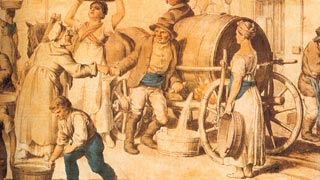History of Vienna's Water Supply
The Origins of Vienna's Water Supply

Already the Romans had spring water diverted from the area of today's Perchtoldsdorf and Gumpoldskirchen to Vienna's predecessor, Vindobona. The Middle Ages, though, entailed a step backwards: until far into the 16th century, the population was exclusively supplied by domestic wells. The first documented water pipeline was built around 1553. This so-called "Siebenbrunn Court Water Pipeline" supplied the imperial palace, some other buildings of the historic city and, much later, one communal well in Margaretenplatz Square. It was followed in 1565 by the oldest town pipeline, the "Hernals Water Pipeline", which fed water from today's 17th municipal district into a well-house in Hoher Markt.
Improvement of water supply
The construction of several smaller pipelines was insufficient to mitigate the frequent water shortages. In the 18th century, "water-men" and "water-women", who sold water from a barrel, became typical fixtures on Vienna's streets - after all, many of the roughly 10,000 domestic wells were contaminated and often caused epidemics. Only the "Albertinian Water Pipeline" (1804; led from the Hütteldorf suburb to Vienna, supplying four suburbs with spring water) and the "Emperor Ferdinand Water Pipeline" (1841/46; the first water pipeline with a branched-off pipeline network, supplying groundwater from the area of Danube Canal) triggered improved water supply for the city. When Vienna began to evolve into a metropolis as a result of the incorporation of the suburbs initiated in 1850, the water supply system was finally revealed as grossly inadequate. The only remedy lay in constructing the First Vienna Spring Water Main.
Vienna Spring Water Mains
City of Vienna | Vienna Water
Contact form
